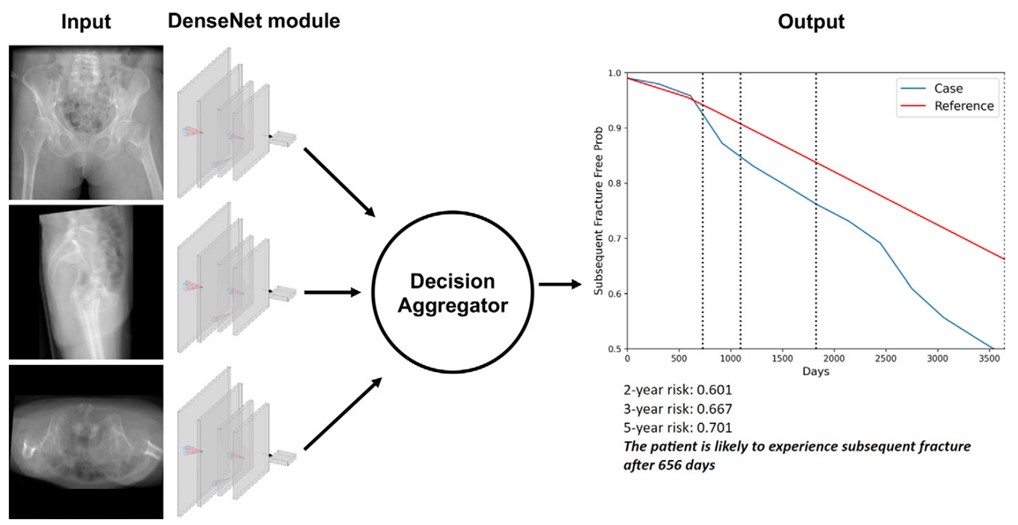Development of a Deep Learning Model for Predicting Subsequent Fracture Risk in Patients with Hip Fracture
- Analyzed CT scans of 1,480 hip fracture patients to design a deep learning model for predicting short-term refracture risk
- Achieved an excellent prediction accuracy (AUROC) of 0.74, surpassing existing fracture prediction tools
A new, convenient method to predict refracture risk in hip fracture patients has been presented. The deep learning model developed by domestic researchers accurately predicts short-term refracture risk within five years, aiding in personalized management and treatment strategies for hip fractures.
Professor Kim Young-gon from the Department of Convergence Medicine at SNUH, Researcher Kim Yi-sak from the Institute of Biomedical Sciences, and Professor Kong Sung-hye from the Department of Endocrinology and Metabolism at Bundang Seoul National University Hospital(SNUBH) developed and validated a short-term refracture risk prediction model based on CT images of 1,480 hip fracture patients. The results were announced on the 17th.
Hip fracture patients are known to have a high risk of refracture, typically occurring between 2 to 4.3 years after the initial fracture. Predicting short-term refracture risk and monitoring high-risk groups are crucial, but existing prediction tools (such as FRAX) have limitations for short-term predictions, necessitating new methods.
The research team focused on 'hip CT images,' which can assess the composition of muscles and bones, to develop the short-term refracture risk prediction model.
They reconstructed the hip CT images of 1,012 patients who visited the hospital for fractures between January 2004 and December 2020, generating frontal, lateral, and transverse images. After extracting features from each image, they designed an ensemble deep learning model that combines these features to calculate the degree of refracture risk freedom (the probability of not experiencing a refracture), expressed as a survival curve.
Additionally, they set 'baseline values' at various time points post-CT scan by analyzing all patients. If the degree of risk freedom falls below these baseline values, the likelihood of refracture increases. By comparing the patient's survival curve with the baseline curve, the model can predict the refracture occurrence time.

[Image] Structure of the Deep Learning Model Developed by the Research Team
Furthermore, the model's performance was tested on 468 hip fracture patients, achieving an AUROC of approximately 0.74 for short-term refracture prediction (0.74 for 2-year, 3-year, and 5-year predictions). An AUROC closer to 1 indicates better prediction performance.
This performance surpasses that of the existing FRAX tool, which had AUROCs of 0.58, 0.64, and 0.70 for 2-year, 3-year, and 5-year predictions, respectively.
Based on these results, the research team emphasized that the CT-based deep learning prediction model accurately predicts short-term refracture risk within five years and can be utilized in the management and treatment strategy planning for patients who have experienced hip fractures.
Professor Kim Young-gon (first author) stated, "The deep learning model developed by our team will help actively identify high-risk refracture groups," adding that "prescribing osteoporosis medication, continuous monitoring, and early rehabilitation for these high-risk groups can mitigate the risk of falls due to hip fractures."
This research was published in the international journal of radiology, 'Radiology (IF: 19.7),' in January.

[Photo form left] Professor Kim Young-Gon and Researcher Kim Yisak of the Department of Transdisciplinary Department of Medicine & Advanced Technology